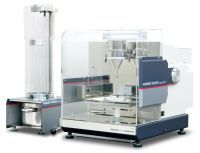- Industries & Machines Industries & Machines
- IIoT IIoT
- Service-Toll Processing Service-Toll Processing
- Material Material
- News News
- IR Information IR Information
-
Sustainability
Sustainability
Sustainability
- Introduction
- Hosokawa Micron Group "Basic Human Rights Policy"
- Sustaibality Policy - Mission Statement
- Editorial Policy
- Integrated Report
- Materiality & Strategy
- Technological contribution to a sustainable global environment
- Contributions towards a safer, more secure and prosperous society
- Sophistication of governance that supports business
- ESG Data Collection
- Sustainable Business Management ~ Finance
- Infromation Disclosure Based on TCFD Recommendations
- Jobs and Careers Jobs and Careers
-
About Us
About Us
About Us
- Greetings (Company Introduction)
- Hosokawa Micron Group "Basic Human Rights Policy"
- Management Philosophy
- Corporate Overview
- Corporate Profile
- Business Areas and Strengths
- Corporate History
- Hosokawa Micron Group
- Domestic Facilities
- Overseas Subsidiaries (Asia)
- Overseas Subsidiaries (Europe)
- Overseas Subsidiaries (America)
- Asian Agents
- Powder Technology Research Institute
- Industrial Property Rights
- Journals and Books
- Technical Information
- Annual Publication "Micromeritics"
- Compliance Charter
- Privacy Policy
- Cookie Policy
- Quality Principle

About Us
- TOP
- About Us
- Corporate History
- The relationship between Hosokawa Micron and measuring instruments
- Greetings (Company Introduction)
- Hosokawa Micron Group "Basic Human Rights Policy"
- Management Philosophy
- Corporate Overview
- Corporate Profile
- Business Areas and Strengths
-
Corporate History
- The founder's relationship with powder technology
- Episode of Eiichi Hosokawa, the founder
- One invention helps a local industry to flourish
- Relationship with powder engineering
- European expansion by a single Japanese
- The relationship between Hosokawa Micron and measuring instruments
- M&A and Mountain range of powder technologies
- Tidbit of M&A
- Expansion into South East Asia
- The beginning of the nanotechnology-based materials business
- Full-scale development with a view to energy reduction
- 100th anniversary
- Newly refurbished main factory
- Hosokawa Micron Group
- Domestic Facilities
- Overseas Subsidiaries (Asia)
- Overseas Subsidiaries (Europe)
- Overseas Subsidiaries (America)
- Asian Agents
- Powder Technology Research Institute
- Industrial Property Rights
- Journals and Books
- Technical Information
- Annual Publication "Micromeritics"
- Compliance Charter
- Privacy Policy
- Cookie Policy
- Quality Principle
The relationship between Hosokawa Micron and measuring instruments
When dealing with objects, it is necessary to quantify and understand their properties. For example, length, weight and hardness are important. With powders, these are difficult to express well (even weight can be measured in many different ways and according to many different standards), but the ease with which a powder can flow is a parameter of particular industrial importance. For example, when you put powder into a container or a bag, the ease with which it flows will affect how much of it you can put into the bag. For example, easy flowing powders such as plant seeds or sand can be easily put into a variety of containers. However, powders such as flour and white powdered sugar, which are difficult to pour into containers, may fall in clumps or become airborne, making them difficult to pour into containers. And even if they do, there are too many gaps in the jar to hold a lot of powder. The trouble is that the flowability of the same powder can vary according to its size, shape, humidity and other external conditions. For this reason, measuring flowability is of great industrial importance.
However, while it is easy to measure the fluidity of easy flowing powders (e.g. by placing them in a funnel and measuring the time it takes for them to fall), there is a problem with hard flowing powders: they get stuck and do not fall. There is a method of expressing the fluidity of such powders, but this method has the problem that the measured value is too small for easy flowing powders, or that it is difficult to see the difference between easy flowing powders.

We were looking for a method to evaluate the flowability of any powder, when we came across a paper by an American. The method was empirical, not theoretical, but it had the advantage that it gave values close to those of human perception for many powders. But proposed methods used a wide range of equipment to measure a variety of parameters, and the descriptions were ambiguous. This is why, in direct contact with the authors of the paper, the "Micromeritcis Lab" has succeeded in developing a single device to quantify the flowability of powders. This is the Powder Tester, of which more than 4,000 units have now been sold worldwide. The method he proposed is known as Carr's method and the values obtained by his method are known as Carr's index or indexes and are used throughout the world. It has now grown to such an extent that the name "Powder Tester Method" is used in papers to indicate that the measurements were obtained using this instrument.
Since the development of this instrument, it has become a technology that forms part of our powder technology chain. As measurement is an essential part of the development of powder engineering, we continue to research and develop various types of equipment in accordance with the purpose for which the institute was founded: "to contribute to the study and investigation of powder processing engineering and its industrialisation".
